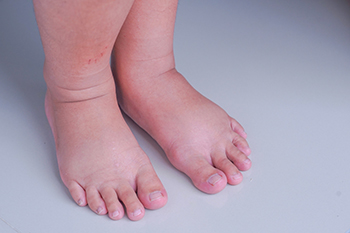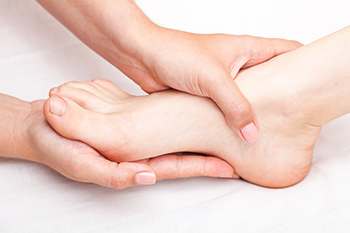Items filtered by date: August 2022
Protecting Diabetic Feet

Most people who are diabetic know the importance of checking their feet daily, even when their feet feel good. Neuropathy is a common condition that can affect diabetic patients, and it is defined as being unable to feel existing cuts, bruises, or scrapes that have developed on the feet. It can happen as a result of damaged nerve endings from increased levels of insulin in the blood. Washing and drying the feet thoroughly is essential in diabetic foot care. It is suggested to refrain from walking barefoot and to wear comfortable shoes. Additionally, trimming the toenails correctly may help to prevent ingrown toenails, and engaging in a mild exercise routine can help to control blood sugar levels. If you have diabetes, it is strongly advised that you are under the care of a podiatrist who can frequently check the condition of your feet and offer you correct management techniques.
Diabetic foot care is important in preventing foot ailments such as ulcers. If you are suffering from diabetes or have any other concerns about your feet, contact one of our podiatrists from Summit Podiatry. Our doctors can provide the care you need to keep you pain-free and on your feet.
Diabetic Foot Care
Diabetes affects millions of people every year. The condition can damage blood vessels in many parts of the body, especially the feet. Because of this, taking care of your feet is essential if you have diabetes, and having a podiatrist help monitor your foot health is highly recommended.
The Importance of Caring for Your Feet
- Routinely inspect your feet for bruises or sores.
- Wear socks that fit your feet comfortably.
- Wear comfortable shoes that provide adequate support.
Patients with diabetes should have their doctor monitor their blood levels, as blood sugar levels play such a huge role in diabetic care. Monitoring these levels on a regular basis is highly advised.
It is always best to inform your healthcare professional of any concerns you may have regarding your feet, especially for diabetic patients. Early treatment and routine foot examinations are keys to maintaining proper health, especially because severe complications can arise if proper treatment is not applied.
If you have any questions please feel free to contact one of our offices located in Wilmington, Whiteville, and Wallace, NC . We offer the newest diagnostic and treatment technologies for all your foot and ankle needs.
Effects of Flat Feet Versus High Arches

Most people do not think too much about what type of foot they have. But it has been found that different foot types can be the source of a number of chronic foot maladies. Foot types range from flat feet to high arches, and anywhere in between. With flat feet, the sole of the foot is flush with the floor when bearing weight. With high arches, the midfoot is stiff and only the toe, heel and outside of the foot touch the ground when standing. People with flat feet often develop inflammation of the tendon on the inside of the ankle, termed posterior tibial tendonitis. People with high arches tend to develop inflammation of the tendon on the outside of the ankle, termed peroneal tendonitis. These conditions occur because of the way the foot absorbs the force produced with every step you take. Other conditions common to those with flat feet include tarsal tunnel syndrome and stress fractures of the 2nd metatarsal. Those with high arches may be more susceptible to ankle instability and sprains, stress fractures of the 5th metatarsal, and sesamoiditis. Both foot types may result in plantar fasciitis. To find out more about your foot type, especially if you are in pain, please consult a podiatrist for an examination and suggestions for treatment.
If you have any concerns about your feet, contact one of our podiatrists from Summit Podiatry. Our doctors can provide the care you need to keep you pain-free and on your feet.
Biomechanics in Podiatry
Podiatric biomechanics is a particular sector of specialty podiatry with licensed practitioners who are trained to diagnose and treat conditions affecting the foot, ankle and lower leg. Biomechanics deals with the forces that act against the body, causing an interference with the biological structures. It focuses on the movement of the ankle, the foot and the forces that interact with them.
A History of Biomechanics
- Biomechanics dates back to the BC era in Egypt where evidence of professional foot care has been recorded.
- In 1974, biomechanics gained a higher profile from the studies of Merton Root, who claimed that by changing or controlling the forces between the ankle and the foot, corrections or conditions could be implemented to gain strength and coordination in the area.
Modern technological improvements are based on past theories and therapeutic processes that provide a better understanding of podiatric concepts for biomechanics. Computers can provide accurate information about the forces and patterns of the feet and lower legs.
Understanding biomechanics of the feet can help improve and eliminate pain, stopping further stress to the foot.
If you have any questions please feel free to contact one of our offices located in Wilmington, Whiteville, and Wallace, NC . We offer the newest diagnostic and treatment technologies for all your foot and ankle needs.
Extra Weight May Equal Foot Pain

If you are obese, which is classified as having a body mass index (BMI) of 30 or higher, you may be putting undue stress on your feet and ankles. Studies show that obese individuals are more likely to have foot pain than those who are not obese. Some conditions that obesity may contribute to include flat feet, plantar fasciitis and other heel pain, hammertoes, and bunions. Also, being obese can increase your chances of having certain diseases that can negatively impact your feet such as gout and diabetes. Aside from trying to lose weight, you can relieve pain and reduce the negative effects of obesity on your feet by choosing better footwear and using custom orthotics in your shoes. Custom orthotics can help to relieve pressure points, support your arch, and distribute your body weight more evenly across your feet. A podiatrist can help you with these proactive measures as well as treat any painful conditions that excess weight may have caused in your feet.
The more you weigh, the harder your feet must work to support your body. If you’re an obese individual and are concerned about your feet, contact one of our podiatrists from Summit Podiatry. Our doctors can provide the care you need to keep you pain-free and on your feet.
Obesity and Your Feet
People who are overweight are putting more pressure on their ankles, knees, and hips as well as their feet. This unfortunately can lead to variety of different issues.
Problems & Complications Stemming from Obesity
- When the body is overweight, it tries to compensate by changing the way that it moves. An obese person may lean forward and put extra weight on the wrong part of the foot. This puts unnecessary stress on the feet.
- Obese people are also more likely to develop type II diabetes which is a condition that causes a lot of foot problems. People with diabetes often don’t feel the cuts and sores that they may have on their feet, which can lead to more complicated and severe issues.
- Plantar fasciitis is another foot condition that can be caused by obesity. Plantar fasciitis is an inflammation of the tissue along the bottom of the foot, which causes pain and stiffness while walking and climbing stairs.
If you have any questions, please feel free to contact one of our offices located in Wilmington, Whiteville, and Wallace, NC . We offer the newest diagnostic and treatment technologies for all your foot care needs.
Causes and Treatment of Swollen Feet

Swelling, called edema, generally occurs when fluid collects in the tissues, commonly in the feet. A number of conditions may lead to edema, including standing for too long, wearing shoes that do not fit properly, eating certain types of food, and various medical conditions. Swollen feet are particularly common among pregnant women, diabetics, and people with heart or circulatory problems. Aging, nutritional deficiencies, and premenstrual syndrome are other factors. A number of easy, at-home remedies can reduce the swelling in your feet. Among them are drinking plenty of water, reducing salt intake, keeping your feet elevated, wearing shoes that fit correctly, and wearing compression socks. Losing weight, eating more foods with potassium, and massaging your feet are other helpful remedies. If the edema in your feet and ankles becomes chronic, especially if you have an underlying health condition such as diabetes or heart disease, it is a good idea to see a podiatrist for a complete examination and appropriate treatment options.
Swollen feet can be a sign of an underlying condition. If you have any concerns, contact one of our podiatrists of Summit Podiatry. Our doctors can provide the care you need to keep you pain-free and on your feet.
Swollen feet are a common ailment among pregnant women and people who stand or sit for extended periods. Aging may increase the possibility of swollen feet and patients who are obese often notice when their feet are swelling too. There may be medical reasons why swollen feet occur:
- Phlebitis - A condition that causes the veins to become inflamed and can also cause leg pain.
- Liver disease - This may lead to low blood levels of albumin which is a protein. This can cause fluid in the blood to pass into the tissues and several areas of the body can become swollen.
- Heart failure - When the heart doesn’t pump properly the blood that is normally pumped back to the heart can pool in the veins of the legs causing swollen feet.
- Kidney disease - One of the main functions of the kidneys is releasing excess fluid in the body. This type of condition can make it difficult for the kidneys to function properly, and as a result the feet may become swollen.
- Deep-vein thrombosis (DVT)- This is a serious condition where blood clots form in the veins of the legs. They can block the return of blood from the legs to the heart which may cause the feet to swell. It is important to be treated by a podiatrist if this condition is present.
Swollen feet can also be caused by bone and tendon conditions, including fractures, arthritis, and tendinitis. Additionally, there may be skin and toenail conditions and an infection may cause the feet to swell. Patients who take medicine to treat high blood pressure may be prone to getting swollen feet.
Many patients elevate their feet to help relieve the swelling and this is generally a temporary remedy. When a podiatrist is consulted the reason behind the swelling can be uncovered and subsequently treated.
If you have any questions please feel free to contact one of our offices located in Wilmington, Whiteville, and Wallace, NC . We offer the newest diagnostic tools and technology to treat your foot and ankle needs.
Do Your Child's Feet Hurt?
Freiberg’s Disease

Freiberg’s disease, also known as Freiberg’s infarction or Frieberg's infraction, is associated with pain in the forefoot. It has to do with the softening of one of the metatarsal heads and typically occurs in teenagers that are growing. If excessive weight is put on this part of the foot, it can lead to a microfracture of the metatarsal head. Symptoms are swelling and discomfort at the ball of the foot and the joint associated with the affected toe – usually the base of the second toe. It is common for one with this affliction to have a long second toe that sustains repetitive force. A person with Freiberg’s disease might limp during the acute phase of the condition and it can become chronic before it is diagnosed. An X-ray or MRI can be used to help diagnose this disease and it is often treated non-invasively, with proper fitting shoes with a wide toe box and metatarsal pads to offset the pressure on the area. Sometimes a walker boot, cast, and/or anti-inflammatory medication is needed to offset weight bearing. There can be a residual deformity of the joint and discomfort that remains over time. However, rarely is surgery done to clean out the joint or shorten the metatarsal. If you/your child is experiencing pain and swelling near the ball of the foot, it is suggested you consult with a podiatrist who can take proper measures to detect the problem and treat it.
Some foot conditions may require additional professional care. If you have any concerns, contact one of our podiatrists of Summit Podiatry. Our doctors can provide the care you need to keep you pain-free and on your feet.
Rare Foot Conditions
The majority of foot conditions are common and can be treated by a podiatrist. Standard diagnostic procedures are generally used to identify specific conditions and treatment can be rendered. A podiatrist also treats rare foot conditions which can be difficult to diagnose and may need extra attention and care.
There are many rare foot conditions that can affect children. Some of these can include:
- Freiberg’s disease
- Kohler’s disease
- Maffucci syndrome
Freiberg’s disease - This can be seen as a deterioration and flattening of a metatarsal bone that exists in the ball of the foot. It typically affects pre-teen and teenage girls, but can affect anyone at any age. Symptoms that can accompany this can be swelling, stiffness, and the patient may limp.
Kohler’s disease - This often targets the bone in the arch of the foot and affects younger boys. It can lead to an interruption of the blood supply which ultimately can lead to bone deterioration. The patient may limp or experience tenderness, swelling, and redness.
Maffucci syndrome - This affects the long bones in a child’s foot leading to the development of abnormal bone lesions. They are benign growths and typically develop in early childhood and the bones may be susceptible to breaking.
A podiatrist can properly diagnose and treat all types of rare foot conditions. If your child is affected by any of these symptoms or conditions, please don’t hesitate to call our office so the correct treatment method can begin.
If you have any questions please feel free to contact one of our offices located in Wilmington, Whiteville, and Wallace, NC . We offer the newest diagnostic tools and technology to treat your foot and ankle needs.

